Chapter Two — Service Tribunals Statistics
Canada’s military justice system is a unique, self-contained system that forms an integral part of the Canadian legal mosaic. This separate, constitutionally valid system consists of a two-tier tribunal structure comprised of summary trials and courts martial.4
In partnership with the Assistant Deputy Minister (Information Management), the Office of the Judge Advocate General is developing the Justice Administration and Information Management System, as part of the Superintendence Enhancement and Assessment Project for Military Justice, which will electronically track military justice files. This tracking system will provide a means for commanders at all levels with real time information regarding military justice matters, including statistical information such as those discussed in this chapter.
The statistics provided in this chapter are a reflection of currently collected data on the military justice system. Given the current limitations of the information collected, it is not possible to provide definitive explanations for increases or decreases from one reporting period to another. In future reporting periods, it is anticipated the Superintendence Enhancement and Assessment Project will provide the necessary metrics to assist in conducting statistical and trend analysis.
Summary Trials
Number of Summary Trials
Although there has been a consistent decline in the number of summary trials held since 2013/14, summary trials continue to be the most widely used form of service tribunal in the Canadian Armed Forces to deal with service offences under the Code of Service Discipline. During this reporting period there were 596 summary trials in comparison to 62 courts martial. The overall percentage of all cases disposed of at summary trial was approximately 91% of trials held before service tribunals. Figure 2-1 shows the number of summary trials and courts martial for the last two reporting periods as well as the corresponding percentage of cases tried by each type of service tribunal and Figure 2-2 shows the total number of summary trials by reporting period since 2013/14.
| Figure 2-1: Distribution of Service Tribunals | ||||
| 2016/175 | 2017/18 | |||
| # | % | # | % | |
| Number of Courts Martial | 56 | 8.38 | 62 | 9.42 |
| Number of Summary Trials | 612 | 91.62 | 596 | 90.58 |
| Total | 668 | 100 | 658 | 100 |

| 2013/14 | 2014/15 | 2015/16 | 2016/17 | 2017/18 | |
| Number of summary trials | 1162 | 857 | 753 | 612 | 596 |
Figure 2-3 shows the total number of summary trials for the last two reporting periods by organization and Figure 2-4 illustrates the number of summary trials specifically for the Canadian Army, the Royal Canadian Navy, the Chief of Military Personnel, the Canadian Joint Operations Command, and the Royal Canadian Air Force from 2013/14.
| Figure 2-3: Number of Summary Trials by Organization | ||||
| Organization | 2016-2017 | 2017-2018 | ||
| # | % | # | % | |
| Canadian Army | 299 | 48.86 | 227 | 38.09 |
| Royal Canadian Navy | 142 | 23.20 | 141 | 23.66 |
| Chief of Military Personnel | 57 | 9.31 | 100 | 16.78 |
| Royal Canadian Air Force | 87 | 14.22 | 60 | 10.07 |
| Canada Joint Operations Command | 14 | 2.29 | 48 | 8.05 |
| Canada Special Operations Forces Command | 4 | 0.65 |
11 | 1.85 |
| Vice Chief of the Defence Staff | 5 | 0.82 | 3 | 0.50 |
| Assistant Deputy Minister (Material) | 2 | 0.33 | 2 | 0.34 |
| Assistant Deputy Minister (Infrastructure and Environment) | 0 | 0.00 | 2 | 0.34 |
| Assistant Deputy Minister (Information Management) | 1 | 0.16 | 1 | 0.17 |
| Canadian Forces Intelligence Command | 1 | 0.16 | 1 | 0.17 |
| Total | 612 | 100 | 596 | 100 |

| 2013/14 | 2014/15 | 2015/16 | 2016/17 | 2017/18 | |
| Canadian Army | 567 | 477 | 357 | 299 | 227 |
| Royal Canadian Navy | 251 | 130 | 186 | 142 | 141 |
| Chief of Military Personnel | 187 | 84 | 82 | 57 | 100 |
| Royal Canadian Air Force | 78 | 75 | 79 | 87 | 60 |
| CJOC |
50 | 60 | 25 | 14 | 48 |
For the Canadian Army, in this reporting period there were a total of 227 summary trials as opposed to 299 for the previous reporting period. That is a decrease of 72 summary trials which represents a decrease of approximately 24% in comparison to the previous reporting period. Since 2013/14 there has consistently been a decrease in the number of summary trials within the Canadian Army for each reporting period.
The Royal Canadian Navy saw a fluctuation in the total number of summary trials between the reporting periods 2013/14 and 2015/16, while the last two reporting periods have remained consistent.
For this reporting period, the Canadian Joint Operations Command had an increase of 34 summary trials in comparison to the previous reporting period, representing an increase of approximately 243%. A contributing factor may have been the increased number of Canadian Armed Forces personnel deployed on operations.
In 2016/17, Operation REASSURANCE held two summary trials, compared to 20 in 2017/18. A total number of two charges were heard in 2016/17, compared to 21 charges in 2017/18. For the 21 charges which took place within the Operation REASSURANCE unit, 19 of those were for section 90 absence without leave offences, compared to one in 2016/17. The other two offences were section 83, disobedience of lawful command.
For the Royal Canadian Air Force, there were 27 fewer summary trials, representing approximately a 31% decrease in the total number of summary trials in comparison to the previous reporting period. There was also a decrease in the total number of charges laid. During the 2016/17 reporting period, there were a total of 133 charges laid compared to this reporting period in which there were 80 charges for a difference of approximately 40%. However, over the five reporting periods the total number of summary trials has been relatively constant.
Finally, the Chief of Military Personnel had the most significant increase in the total number of summary trials compared to the previous reporting period. The total number increased from 57 to 100, representing an approximate increase of 75%.
While at this time it is not possible to determine the specific reasons for the increase, a number of factors may have contributed, including an increased number of summary trials within training establishments.
With regards to the section 129 offences, during the 2016/17 reporting period, all eight charges fell under the "Other" category.6 During this reporting period, 22 fell under the "Other" category, while four were alcohol or drug related offences, three were related to personal relationships, and five were of a sexual misconduct nature.
Number of Charges Disposed of by Summary Trial
In this reporting period, there were a total of 802 charges disposed of at summary trial compared to 908 charges disposed of at summary trial during the 2016/17 reporting period. Figure 2-5 shows the total number of charges disposed of at summary trial since 2013/14, which demonstrates a consistent decrease in the overall number of charges disposed of at summary trial.
The two most common types of offences which account for approximately 66% of all charges in the summary trial system are absence without leave and conduct to the prejudice of good order and discipline.
Since the 2013/14 reporting period there has been a consistent decline in the total number of charges reported for absence without leave. In the current reporting period the total number was 305 compared to 667 charges for absence without leave in the 2013/14 reporting period.
In this reporting period there were a total of 223 charges for the offence of conduct to the prejudice of good order and discipline. This is an increase compared to the previous reporting period of 140 charges. However, there continues to be an overall decline when compared to 2013/14 which had a peak of 711 charges for conduct to the prejudice of good order and discipline. Figure 2-6 shows the number of charges for absence without leave and conduct to the prejudice of good order and discipline between 2013/14 and 2017/18.

| 2013/14 | 2014/15 | 2015/16 | 2016/17 | 2017/18 | |
| Number of Charges Disposed of at Summary Trial | 1806 | 1225 | 1128 | 908 | 802 |

| 2013/14 | 2014/15 | 2015/16 | 2016/17 | 2017/18 | |
| Absence without Leave | 667 | 475 | 470 | 425 | 305 |
| Prejudice to Good Order and Discipline | 711 | 404 | 315 | 140 | 223 |
Number of Elections to be Tried by Court Martial
Pursuant to the Queens Regulations and Orders for the Canadian Forces article 108.17, an accused person has the right to elect to be tried by court martial rather than summary trial except where the accused: (1) has been charged with one of five minor service offences; and (2) the circumstances surrounding the commission of the offence are sufficiently minor in nature that the officer exercising summary trial jurisdiction over the accused concludes that a punishment of detention, reduction in rank or a fine in excess of 25% of the accused’s monthly basic pay would not be warranted if the accused were found guilty of the offence.
The five minor offences are: (1) insubordinate behaviour, (2) quarrels and disturbances, (3) absence without leave, (4) drunkenness, and (5) conduct to the prejudice of good order and discipline where the offence relates to military training, maintenance of personal equipment, quarters or work space, or dress and deportment.7
During this reporting period, 180 elections to be tried by court martial were offered to accused members. Of the 180 elections offered, the accused elected summary trial 143 times, representing approximately 79% of the elections provided. There were 145 summary trials completed within this reporting year, where an election was offered. Two of these summary trials were a result of an election offered in the 2016/17 reporting period.
In the current reporting period, 37 accused elected to be tried by court martial, representing approximately 21% of the elections offered. Figure 2-7 represents the percentage of accused persons electing court martial when one was offered over the past five reporting periods.
Figure 2-8 shows the number of summary trials completed for the past five reporting periods in which the accused person was offered an election as well as the number of cases in which no election was offered. Figure 2-9 shows the percentage of summary trials completed per reporting period where an accused was offered an election.

| 2013/14 | 2014/15 | 2015/16 | 2016/17 | 2017/18 | |
| Percentage of Accused Electing to be Tried by Court Martial | 16.34 | 21.48 | 23.51 | 24.20 | 20.56 |

| 2013/14 | 2014/15 | 2015/16 | 2016/17 | 2017/18 | |
| Election Not Offered | 824 | 601 | 526 | 448 | 451 |
| Election Offered | 338 | 256 | 227 | 164 | 145 |

| 2013/14 | 2014/15 | 2015/16 | 2016/17 | 2017/18 | |
| Percentage of Summary Trials Completed where Accused Offered an Election | 29.1 | 29.9 | 30.2 | 26.8 | 24.33 |
Results by Charge at Summary Trial
The percentages of all findings by charge have remained relatively constant on a year to year basis. For example, the percentage of guilty findings has remained relatively constant at approximately 89%. The percentage of not guilty findings has decreased by 2.6% compared to the previous reporting period. A complete breakdown of the total number of findings by charge and the corresponding percentage for the last two reporting periods can be found at Figure 2-10.
| Figure 2-10: Results by Charge | ||||
| 2016-2017 | 2017-2018 | |||
| # | % | # | % | |
| Guilty | 783 | 86.23 | 717 | 89.40 |
| Guilty – Special Finding | 8 | 0.88 | 8 | 1.00 |
| Not guilty | 93 | 10.24 | 61 | 7.61 |
| Charge stayed | 21 | 2.32 | 15 | 1.87 |
| Charge not proceeded with | 3 | 0.33 | 1 | 0.12 |
| Total | 908 | 100 | 802 | 100 |
Punishments at Summary Trial
This reporting period there were a total of 782 punishments imposed at summary trial8. Of those possible punishments which can be imposed at summary trial, fines and confinement to ship or barracks continue to be imposed more frequently.
Figure 2-11 shows the total number of punishments imposed at summary trial for the last two reporting periods as well as the corresponding percentage of each punishment over that same period.
| Figure 2-11: Punishments at Summary Trial | ||||
| 2016-2017 | 2017-2018 | |||
| # | % | # | % | |
| Detention | 10* | 1.25 | 8* | 1.02 |
| Reduction in rank | 9 | 1.12 | 4 | 0.51 |
| Severe reprimand | 1 | 0.12 | 2 | 0.26 |
| Reprimand | 42 | 5.23 | 31 | 3.96 |
| Fine | 444 | 55.29 | 438 | 56.01 |
| Confinement to ship or barracks | 208 | 25.9 |
204 | 26.09 |
| Extra work and drill | 57 | 7.10 | 45 | 5.76 |
| Stoppage of leave | 14 | 1.70 | 22 | 2.81 |
| Caution | 18 | 2.24 | 28 | 3.58 |
| Total | 803 | 100 | 782 | 100 |
| * Includes three punishments for which the carrying into effect was suspended | ||||
In this reporting period the punishment of detention was imposed eight times when compared to the 2013/14 reporting period where the punishment of detention was imposed 32 times. An overview of the number of times the punishment of detention was imposed at summary trial over the past five years can be found in Figure 2-12.

| 2013/14 | 2014/15 | 2015/16 | 2016/17 | 2017/18 | |
| Total Punishments of Detention | 32 | 26 | 25 | 10 | 8 |
Summary Trial Reviews
In the current reporting period, a total of 26 summary trials were reviewed based on requests by members found guilty at summary trial or on a review authority’s own initiative. As there was a total of 596 summary trials, the percentage of cases that were subject to a review was approximately 4%. Of those reviews, 11 were based on finding, nine on sentence, and six were based on both finding and sentence. This percentage is consistent with that of the previous reporting period when approximately 4% of cases were reviewed. Figure 2-13 shows the percentage of cases for which a review of the finding, the sentence or both were conducted since 2013/14.
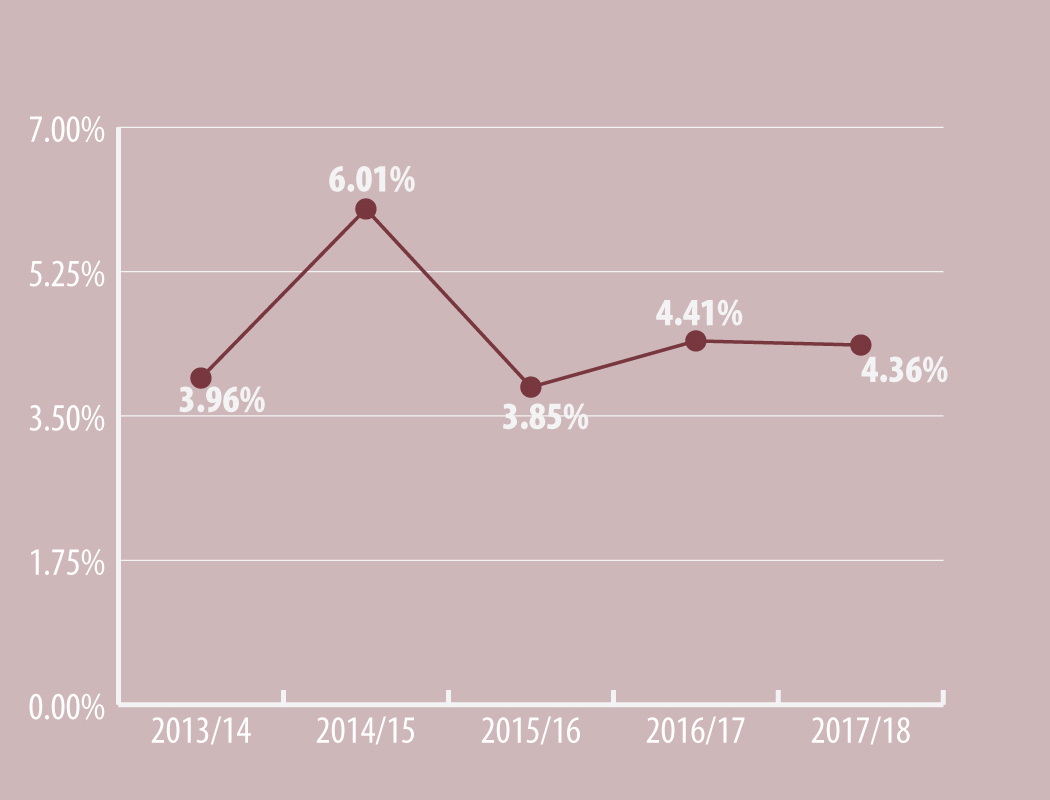
| 2013/14 | 2014/15 | 2015/16 | 2016/17 | 2017/18 | |
| Percentage of Summary Trials Reviewed | 3.96 | 6.01 | 3.85 | 4.41 | 4.36 | >
Based on the nature of the request for review, a review authority has several options available to them to deal with the matter including upholding the decision of the presiding officer, quashing the finding of guilt, and substituting the finding or punishment. In approximately 23% of all decisions a reviewing authority quashed the decision of the presiding officer. In approximately another 54% of all decisions a reviewing authority upheld the decision of the presiding officer. In the previous reporting period approximately 39% of decisions by the review authority were to uphold the findings. A complete breakdown of all decisions of a review authority and the corresponding percentage of each decision for the past two reporting periods can be found at Figure 2-14.
| Figure 2-14: Decisions of Review Authority | ||||
| 2016-2017 | 2017-2018 | |||
| # | % | # | % | |
| Upholds decision | 11 | 39.29 | 14 | 53.85 |
| Quashes findings | 11 | 39.29 | 6 | 23.08 |
| Substitutes findings | 2 | 7.14 | 2 | 7.69 |
| Substitutes punishment | 0 | 0.00 | 1 | 3.85 |
| Mitigates / commutes / remits punishment | 4 | 14.29 | 3 | 11.53 |
| Total | 289 | 100 |
26 | 100 |
Harmful and Inappropriate Sexual Behaviour, Sexual Misconduct and Personal Relationships
At the summary trial level, charges include: inappropriate sexual behaviour; sexual misconduct; and adverse personal relationship.10 These offences were charged pursuant to section 129 of the National Defence Act, conduct to the prejudice of good order and discipline. Failure to report a personal relationship when required to do so may result in a charge, such cases are also included in this section.
In the current reporting period there were a total of 24 charges for Harmful and Inappropriate Sexual Behaviour as well as Sexual Misconduct compared to 26 charges in the previous reporting period.
The number of charges related to adverse personal relationships has increased. In the previous reporting period there were two charges related to adverse personal relationships as compared to seven for the current reporting period.11
Language of Summary Trials
As an accused may choose to have his or her summary trial conducted in either official language, the presiding officer must be able to understand the language in which the proceedings are to be conducted without the assistance of an interpreter. Where the presiding officer lacks the required language ability, he or she should refer the case to another presiding officer who has the required language ability to try the case.
This reporting period, approximately 83% of summary trials were conducted in English and 17% were conducted in French. These percentages are consistent when compared to previous reporting periods. Figure 2-15 shows the number of summary trials conducted in both English and French for the past two reporting periods.
| Figure 2-15: Language of Summary Trials | ||||
| 2016-2017 | 2017-2018 | |||
| # | % | # | % | |
| English | 523 | 85.46 | 492 | 82.55 |
| French | 89 | 14.54 | 104 | 17.45 |
| Total | 612 | 100 | 596 | 100 |
Timelines for Summary Trials
The purpose of the summary trial system is to provide prompt but fair justice in respect of minor service offences and as such, these trials are required to begin within one year of the date on which the offence is alleged to have been committed.12
This reporting period, there were 596 summary trials and the average number of days from the date of the alleged offence to the start date of the summary trial was approximately 87 days. Of those 596 summary trials, 394 were disposed of within 90 days of the alleged incident, representing approximately 66% of all summary trials for the reporting period. Further, approximately 88% of all summary trials were commenced within 180 days of the alleged incident. Figure 2-16 shows a breakdown of the number of days from the date of the alleged offence to the commencement of the summary trial.
Once a charge has been laid by the appropriate authority and is referred to a presiding officer, the presiding officer may be required to obtain legal advice before commencing the summary trial. Once that advice has been received from the unit legal adviser, the presiding officer may commence the summary trial.
Over the past five years, the number of days between the time of charge to the start of the summary trial has increased to reach a peak of just under 20 days in the previous reporting period. During the current reporting period, this number has decreased to approximately 15 days. Figure 2-17 shows the average number of days from charge laid to the start of the summary trial over the last five reporting periods.
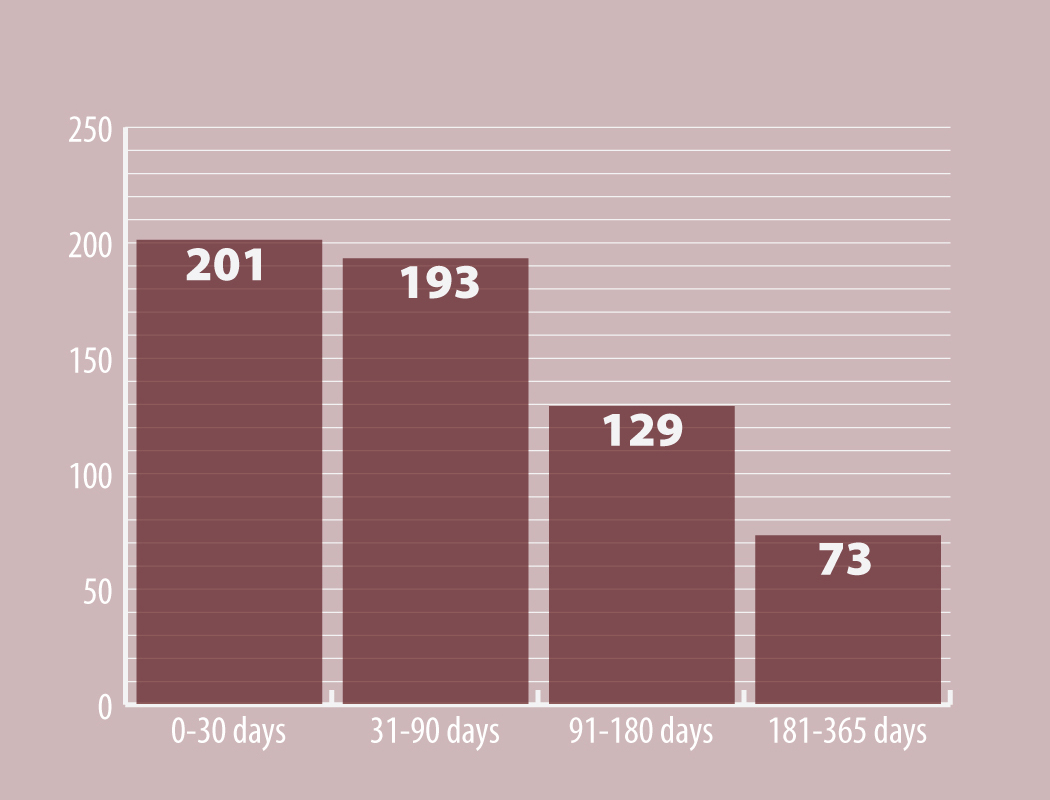
| 0-30 days | 31-90 days | 91-180 days | 181-365 days | |
| Number of Cases | 201 | 193 | 129 | 73 |

| 2013/14 | 2014/15 | 2015/16 | 2016/17 | 2017/18 | |
| Number of Days | 17.2 | 16.9 | 17.4 | 19.8 | 15.6 |
Courts Martial
Number of Courts Martial
During this reporting period, there were a total of 62 courts martial completed, representing approximately 9% of all service tribunals and a 11% increase in Courts Martial from the previous reporting period. Figure 2-18 demonstrates the number of courts martial by year since 2013/14.

| 2013/14 | 2014/15 | 2015/16 | 2016/17 | 2017/18 | |
| General Courts Martial | 7 | 10 | 7 | 4 | 5 |
| Standing Courts Martial | 60 | 60 | 40 | 52 | 57 |
Results by Case at Court Martial
Of the 62 courts martial held this year, 51 of the 62 accused were either found guilty or pleaded guilty to at least one charge and 11 were found not guilty on all charges. Figure 2-19 shows disposition by case over the past two reporting periods.
| Figure 2-19: Disposition of Cases at Court Martial | ||||
| Disposition | 2016-2017 | 2017-2018 | ||
| # | % | # | % | |
| Found Guilty of at least one charge | 46 | 82.14 | 51 | 82.26 |
| Found Not Guilty of all charges | 8 | 14.29 | 11 | 17.74 |
| Stay of all charges | 1 | 1.79 | 0 | 0.00 |
| Withdrawal of all charges | 0 | 0.00 | 0 | 0.00 |
| Mistrial | 1 | 1.79 | 0 | 0.00 |
| Total | 56 | 100 |
62 | 100 |
Director of Military Prosecutions Case Management
Referrals
During this reporting period, the Director of Military Prosecutions received a total of 118 referrals compared to 126 in the previous reporting period, a decline of 6%. Although fewer referrals were received by the Director of Military Prosecutions in 2017/18, there were a higher number of cases carried over, resulting in a total of 199 referrals processed in 2017/18 as compared to 190 in 2016/17, or an increase of 5%. Of these 199 cases, post-charge decisions were made by the Canadian Military Prosecution Service in 120 of them with the remainder carried over to the next reporting period.
Figure 2-20 shows the number of referrals received by the Director of Military Prosecutions over the last five years with a comparison as to how many were processed within each respective reporting period.
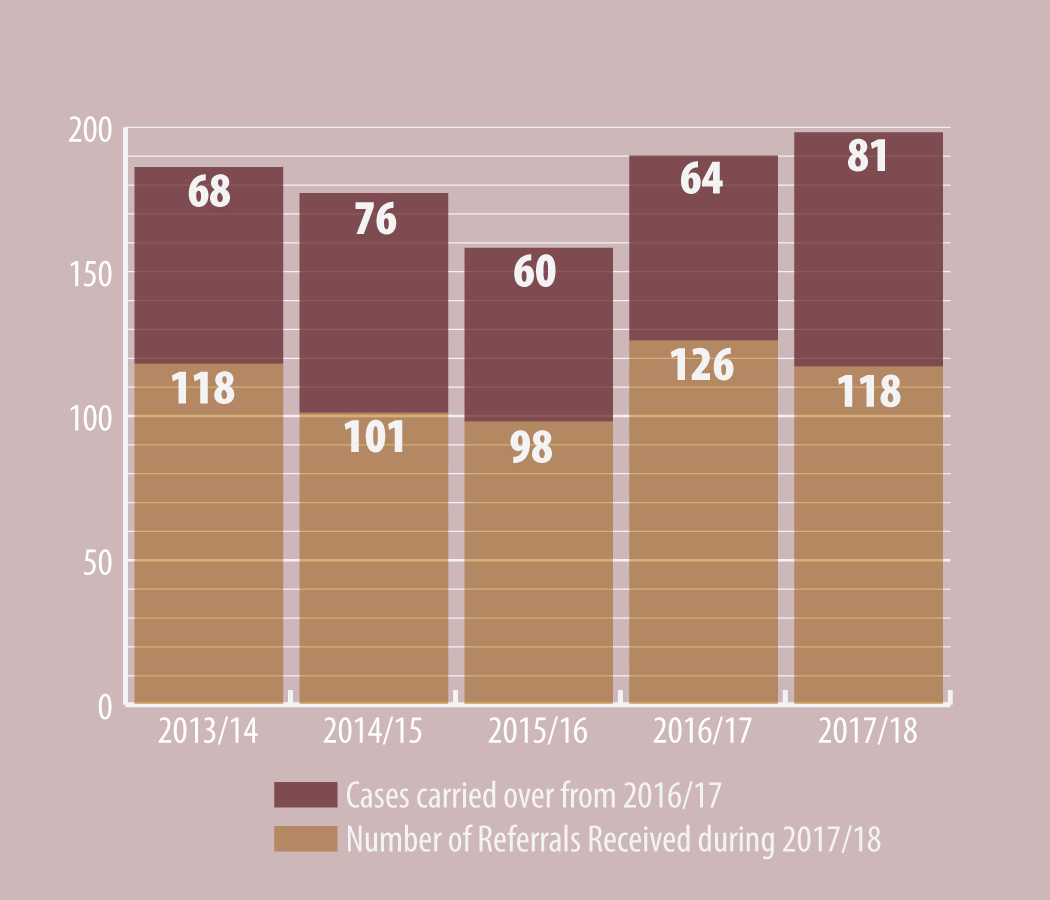
| 2013/14 | 2014/15 | 2015/16 | 2016/17 | 2017/18 | |
| Cases carried over from 2016/17 | 68 | 76 | 60 | 64 | 81 |
| Number of Referrals Received during 2017/18 | 118 | 101 | 98 | 126 | 118 |
Preferrals and Non-Preferrals13
During this reporting period there were 55 files preferred for trial by court martial and 41 cases in which no charges were preferred. The percentage of cases preferred for trial by court martial for this reporting period was approximately 57%, with 22 cases awaiting a post-charge decision. As with the 2016/17 reporting period in which 82 files were preferred, or 65%, this remains consistent with the past five reporting periods. In the past five reporting periods, the highest rate of preferrals was 69% in 2013/14 and the lowest rate of preferrals was 57% in 2017/18.
Figure 2-21 illustrates the number of files preferred by the Director of Military Prosecutions and the number of files where no charges were preferred over the past five reporting periods.
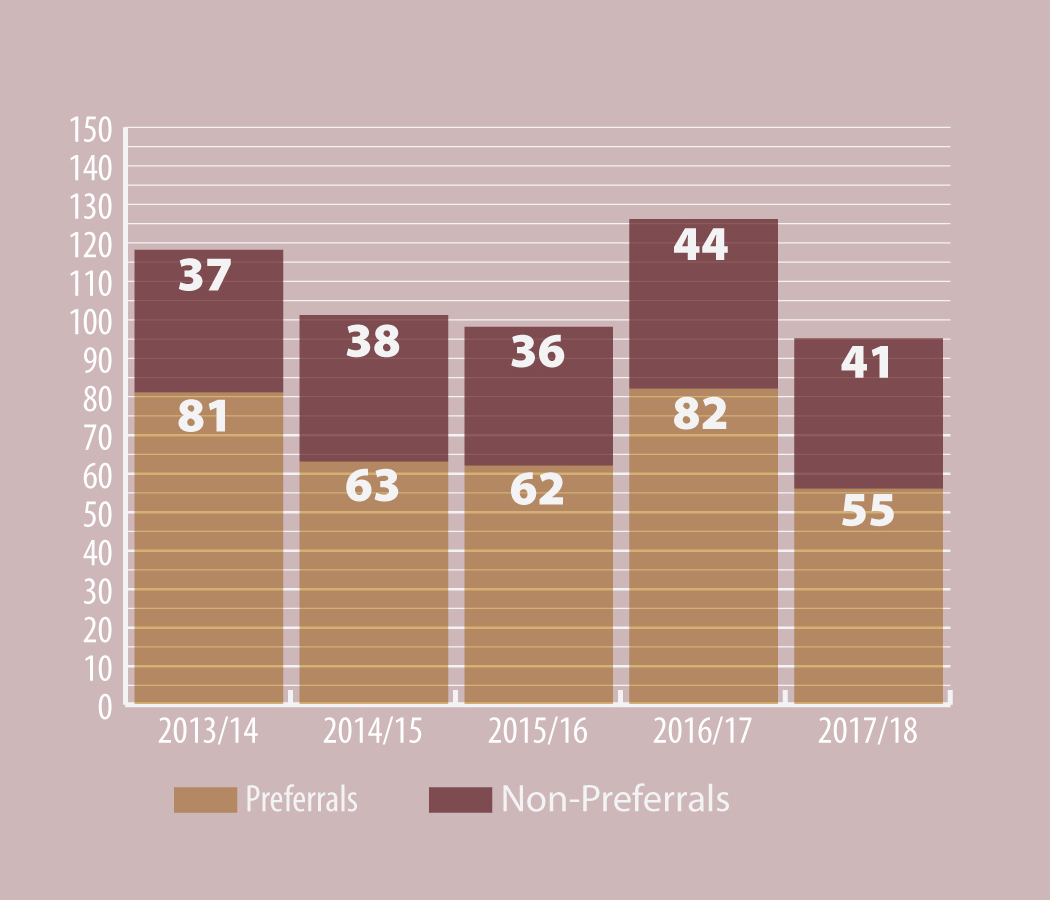
| 2013/14 | 2014/15 | 2015/16 | 2016/17 | 2017/18 | |
| Preferrals | 37 | 38 | 36 | 44 | 41 |
| Non-Preferrals | 81 | 63 | 62 | 82 | 55 |
Director of Defence Counsel Services Representation
When a person appears before a Military Judge, a Court Martial, the Court Martial Appeal Court or the Supreme Court of Canada, they have the right to be represented by counsel assigned by the Director of Defence Counsel Services at public expense or they may retain civilian counsel at their own expense or choose to self-represent.
During this reporting period, the Director of Defence Counsel Services provided legal representation to accused persons in 200 referred files, which included 96 cases from the previous reporting period which were still awaiting disposition at the commencement of this reporting period. Of these 200 files, 115 were completed during this reporting period. Of the completed files, 60 had the charges withdrawn without proceeding to a trial but requiring some level of legal representation by the Director of Defence Counsel Services. The remaining 55 cases resulted in 10 cases where the accused was found not guilty on all of the charges and 45 cases in which the accused was either found guilty or pled guilty to at least one of the charges.
Court Martial Sitting Days
During this reporting period there was a decline in the total number of court martial sitting days with a total of 173 days, an average of 2.79 days per trial, as compared to 213 days in the previous reporting period. This represented the lowest average number of days per trial over the past five years with the highest average number of days being 3.83 days per trial during the 2015/16 reporting period. The overall five year average for sitting days per court martial is 3.33 days. Figure 2-22 shows the total number of court martial sitting days over the past five reporting periods.
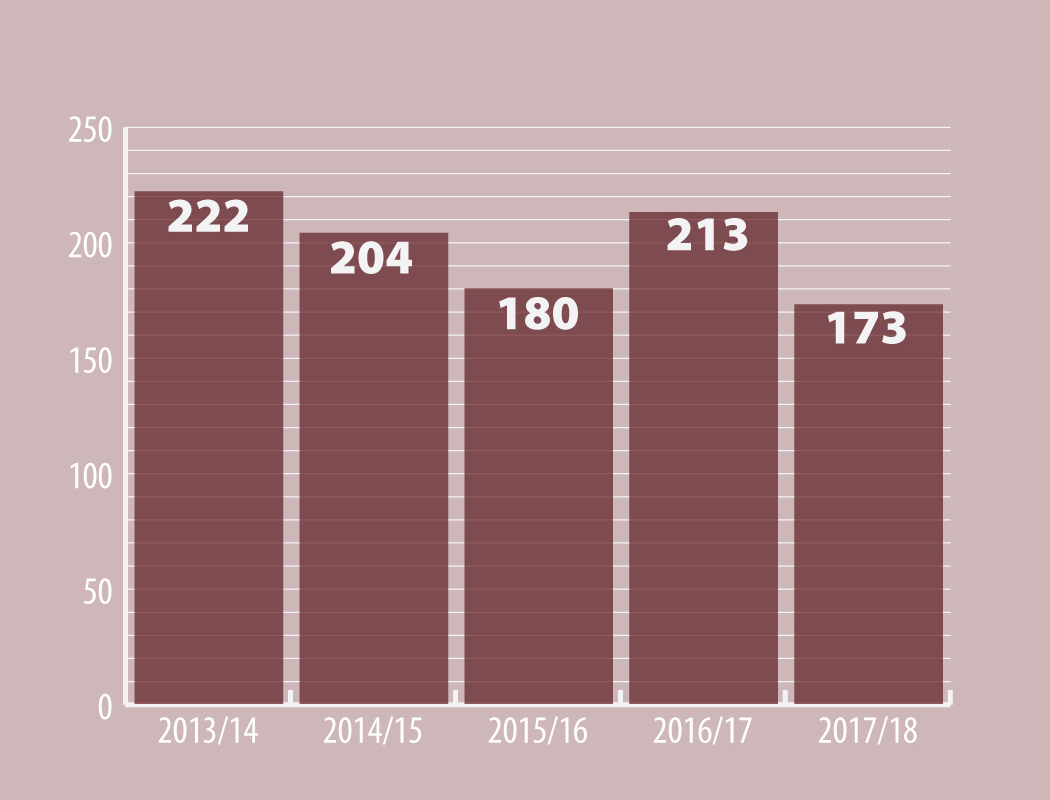
| 2013/14 | 2014/15 | 2015/16 | 2016/17 | 2017/18 | |
| Court Martial Sitting Days | 222 | 204 | 180 | 213 | 173 |
Timelines
During this reporting period the average number of days from referral of a matter to the Director of Military Prosecutions until charges against an accused were preferred was approximately 95 days, an increase of approximately six days or 7% from the previous year. Figure 2-23 illustrates the average number of days from referral to preferral over the course of the past five reporting periods.
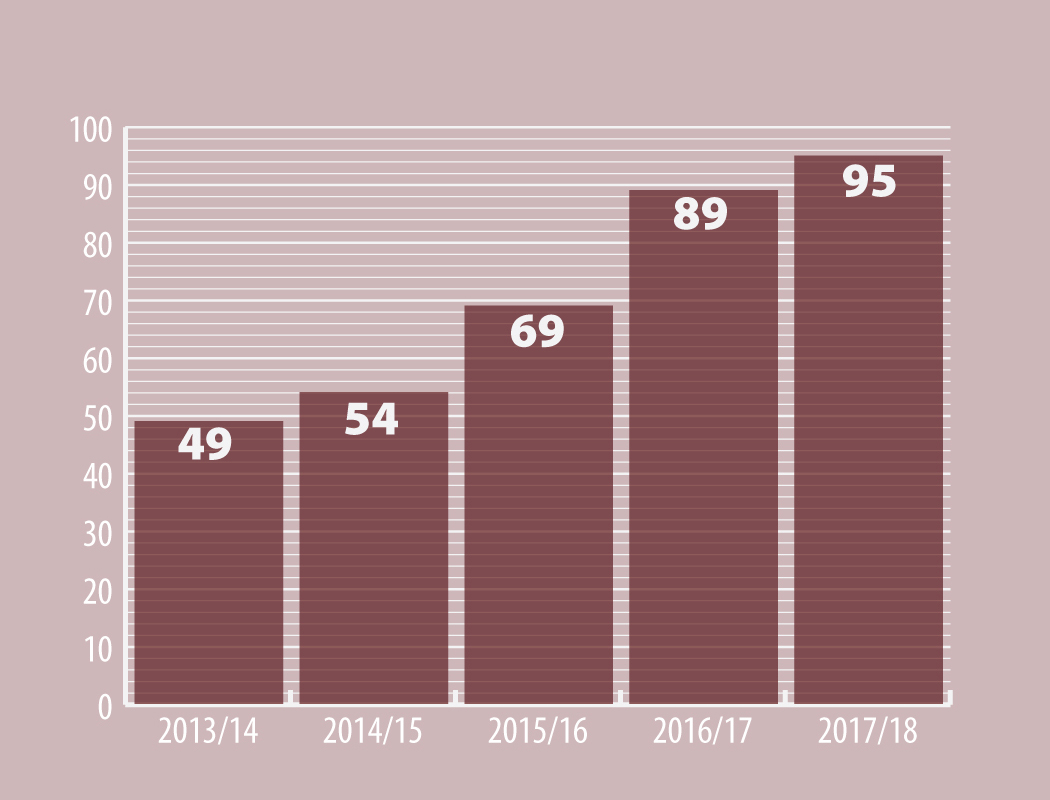
| 2013/14 | 2014/15 | 2015/16 | 2016/17 | 2017/18 | |
| Number of Days | 49 | 54 | 69 | 89 | 95 |
During this reporting period, the average length of time it took for the commencement of a court martial following the preferral of charges against an accused was 211 days, a decrease from the previous reporting period by an average of 39 days, or 16%. The total number of days from the preferral of a charge to the commencement of a court martial in the previous reporting period was 250 days. Figure 2-24 demonstrates the average length of time for a court martial to commence once charges against an accused were preferred over the course of the past five years.
Along with a decrease in the number of days between the preferral of charges to the beginning of a court martial, there was also a decrease in the number of calendar days from the date of the Record of Disciplinary Proceedings to completion of the court martial. The overall process from the date of the Record of Disciplinary Proceedings to the completion of the court martial was 402 days, 7% faster than the previous reporting period which had a total of 434 days, bringing the five year average to 384 days. Figure 2-25 shows the average number of days from the time it takes for a file to move through the referral process once a charge has been laid to the completion of a court martial for the past five reporting periods.
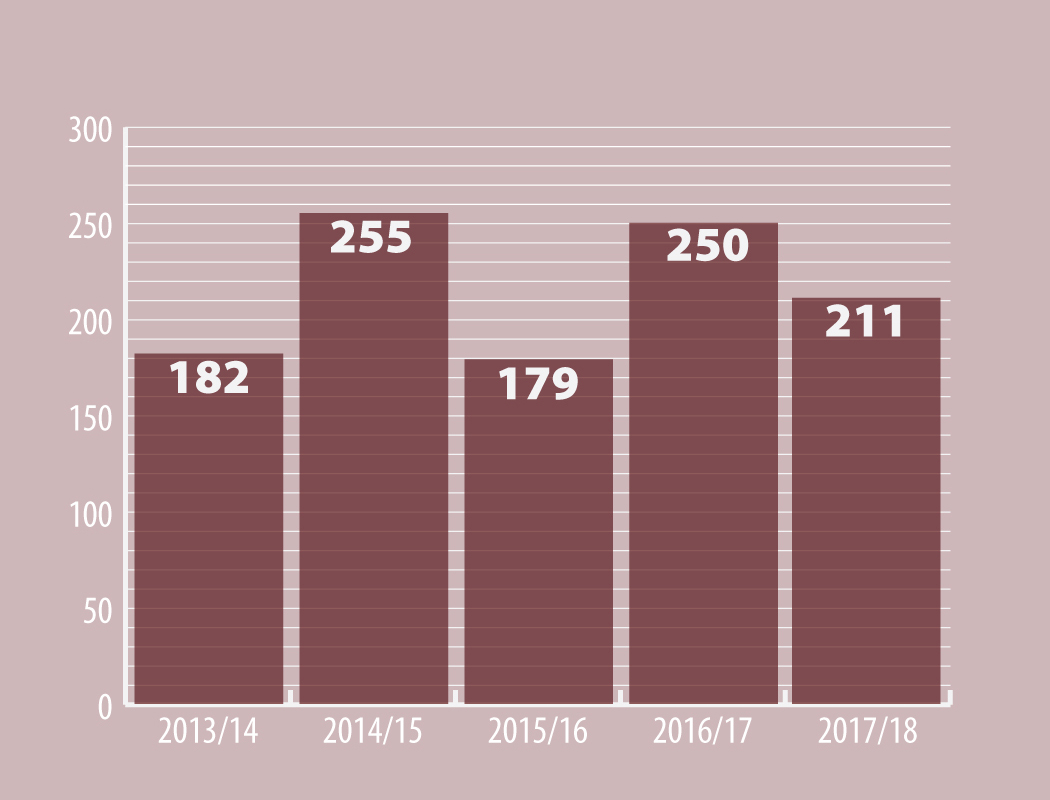
| 2013/14 | 2014/15 | 2015/16 | 2016/17 | 2017/18 | |
| Number of Days | 182 | 255 | 179 | 250 | 211 |
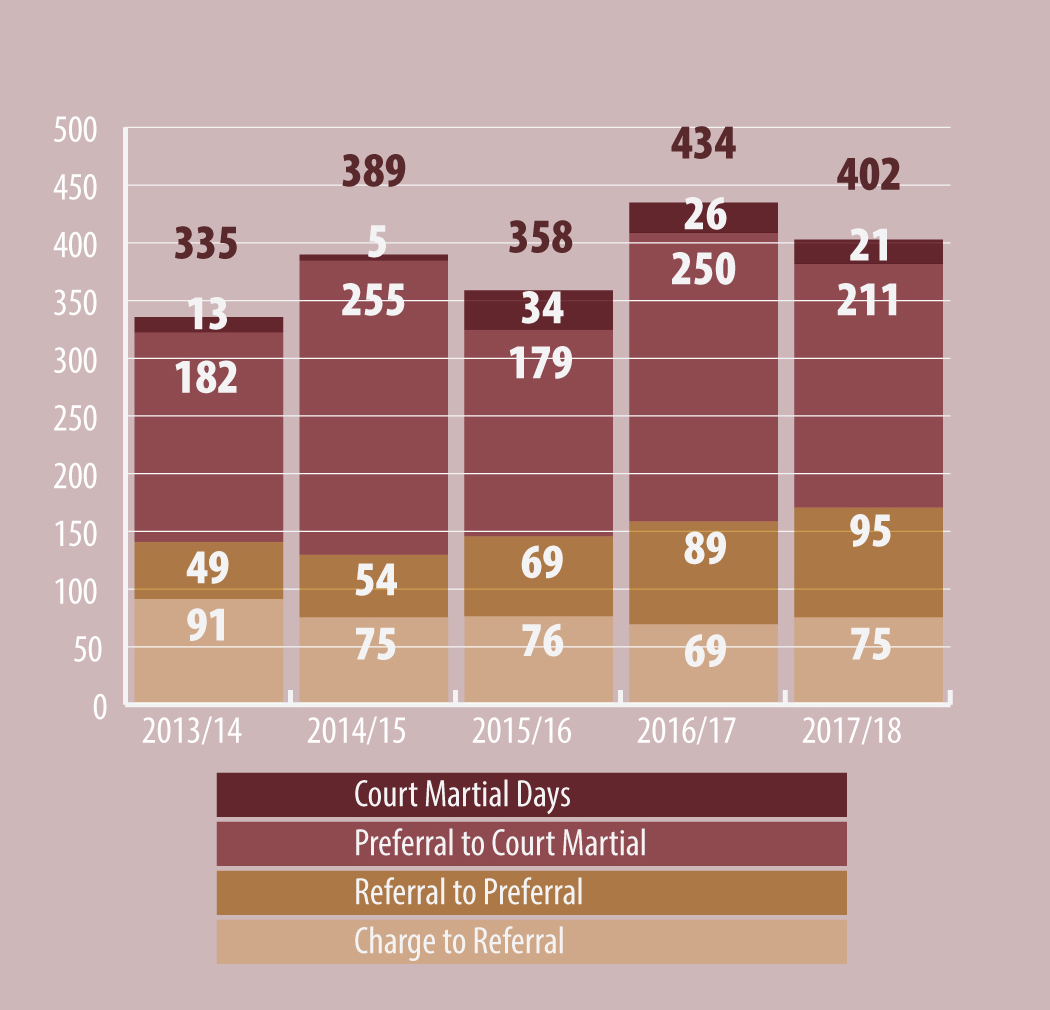
| 2013/14 | 2014/15 | 2015/16 | 2016/17 | 2017/18 | |
| Court Martial Days | 13 | 5 | 34 | 26 | 21 |
| Preferral to Court Martial | 182 | 255 | 179 | 250 | 211 |
| Referral to Preferral | 49 | 54 | 69 | 89 | 95 |
| Charge to Referral | 91 | 75 | 76 | 69 | 75 |
| Total | 355 | 389 | 358 | 434 | 402 |
Punishments at Court Martial
While only one sentence may be passed on an offender at a court martial, more than one punishment may be given as part of the sentence. In the 2017/18 reporting period, 51 sentences were pronounced by courts martial, involving a total of 95 punishments. The most common punishment imposed were fines, 38 in total, representing 40% of punishments, followed by 20 reprimands, or 21%. A total of 11 custodial punishments, representing approximately 12% of punishments, were imposed by courts martial, including seven imprisonments and four detentions, three of which were suspended. Figure 2-26 breaks down the punishments imposed by courts martial over the past two reporting periods.
| Figure 2-26: Punishments at Courts Martial | ||
| 2016-2017 | 2017-2018 | |
| Dismissal | 1 | 3 |
| Imprisonment | 4 | 7 |
| Detention | 4* | 4** |
| Reduction in Rank | 9 | 9 |
| Severe Reprimand | 6 | 11 |
| Reprimand | 17 | 20 |
| Fine | 39 | 38 |
| Confinement to Ship or Barracks | 0 | 1 |
| Stoppage of leave | 0 | 1 |
| Caution | 0 | 1 |
| Total | 80 | 95 |
| * One of these punishments were suspended by the Military Judge. ** Three of these punishments were suspended by the Military Judge. |
||
Sexual Misconduct
The National Defence Act and the Criminal Code provide for a number of offences for which an accused may be tried at court martial for sexual misconduct. These offences include, but are not limited to, sexual assault, assault, accessing or possessing child pornography, disgraceful conduct, prejudice to good order and discipline, and ill-treatment of subordinates.
During the 2017/18 reporting period, 40 referrals for sexual misconduct offences were received by the Director of Military Prosecutions wherein 28 files were preferred, or 70%, for Court Martial with five, or 12.5%, pending a decision by the Director of Military Prosecutions.
A total of 20 Courts Martial dealing with sexual misconduct charges were completed, 14, or 70%, of those resulting in a guilty finding, one court martial, or 5% of the trials, resulting in a guilty finding of a lesser and included offence and five courts martial, or 25%, resulting in findings of not guilty.
A complete breakdown of all courts martial for sexual misconduct can be found in Annex C.
Footnotes
4 Further information concerning the military justice system and its structure can be found at http://www.forces.gc.ca/en/about-reports-pubs-military-law/military-justice-overview.page.
5 All summary trial statistics from the 2016/17 reporting period and which are reported in this report may differ from those statistics reported in the 2016/17 Annual Report of the Judge Advocate General as a result of late reporting by various units across the Canadian Armed Forces.
6 For the purposes of tabulating results, the offences of conduct to the prejudice of good order and discipline have been sub-divided into a number of categories including unauthorized discharge, sexual harassment, inappropriate relationship, alcohol related, drug related and other. For a detailed breakdown of the number of charges in each sub-category please refer to Annex B.
7 An accused will also not have the right to choose to be tried by court martial or summary trial in those circumstances where the charges require a direct referral to court martial.
8 More than one type of punishment may be imposed at a summary trial.
9 In one case the review authority took two separate decisions in one request for review. The review authority reviewed both finding and punishment at the request of the accused.
10 Harmful and Inappropriate Sexual Behaviour is defined in Operation HONOUR as "behaviours that are inconsistent with the Profession of Arms" and may include such behaviour as unacceptable language or jokes, actions that devalue members on the basis of their sex, sexuality, or sexual orientation, accessing, distributing, or publishing in the workplace material of a sexual nature, offensive sexual remarks, exploitation of power relationships for the purposes of sexual activity, unwelcome requests of a sexual nature, verbal abuse of a sexual nature, or the publication of an intimate image of a person without their consent, voyeurism, indecent acts, sexual interference, sexual exploitation, and sexual assault. Sexual Misconduct is defined in Defence Administrative Order and Directive (DAOD) 5019-5 as an act that is either of sexual nature or committed with the intent to commit an act(s) that is sexual in nature and constitutes an offence under the Criminal Code or Code of Service Discipline. Such acts may include sexual assault, indecent exposure, voyeurism, or acts involving child pornography. DAOD 5019-1 defines an adverse personal relationship as a personal relationship which has a negative effect on the security, cohesion, discipline or morale of a unit.
11 Two charges for inappropriate personal relationships stemmed from one incident where both members failed to report their personal relationship as required by DAOD 5019-1: Personal Relationships and Fraternization.
12 See subsections 163(1.1) and 164(1.1) of the National Defence Act.
13 In accordance with the Director of Military Prosecutions Policy Directive # 003/00, Post Charge Review, when considering whether or not a charge will be preferred, the Prosecutor must determine if there is a reasonable prospect of conviction and whether the public interest requires that a prosecution be pursued at the post-charge stage. Further information concerning the Director of Military Prosecutions Policies regarding post-charge review can be found at http://www.forces.gc.ca/assets/FORCES_Internet/docs/en/about-policies-standards-legal/dmp-policy-directive-003-post-charge-review.pdf.